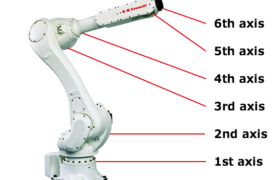Are the structures of robots and humans the same?
Robots and humans share a common feature. Humans and mechanical robots—as opposite as they may seem, they, in fact, share the same underlying structure of links (bones) and joints. The basic skeleton of industrial robots, of which is made up of mainly robotic arms, is a combination of links and joints. Relating it to a human body, parts that can freely bend and move about, such as the elbow and shoulder, are the joints, and the bones connecting those joints are equivalent to a robot’s links. The principle of moving joints and transmitting power through the links is common in both humans and robots.
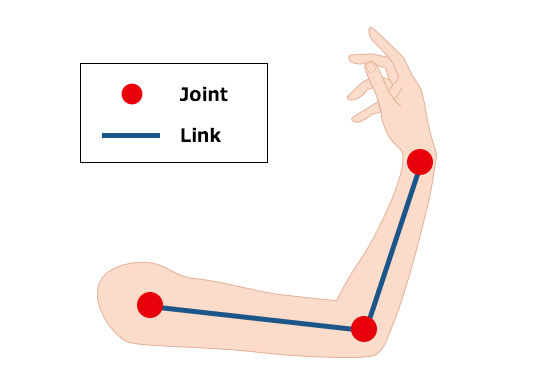
Robots are roughly categorized into two types according to how their links are arranged: 1) serial link and 2) parallel link. The human arm is categorized as a serial link since its joints—the shoulder, arm and wrist—are aligned in series.
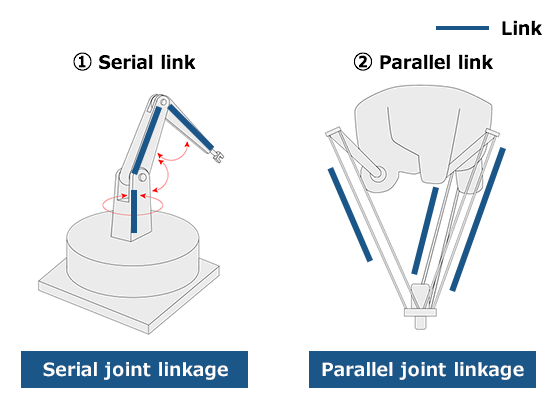
Industrial robots are classified into several categories such as vertical articulated type and horizontal articulated type (Selective Compliance Assembly Robot Arm-SCARA), depending on the joint movements and the structure. Please see the article below for more information.
In this article, the motion and the internal makeup of industrial robots will be explained.
Robot and human motion comparison
Now, let’s take a look at the movement of a vertical articulated type having the same mechanical structure as a human arm as an example.
A vertical articulated robot is an industrial robot with a serial link structure. It is generally composed of six joints (6 axes).
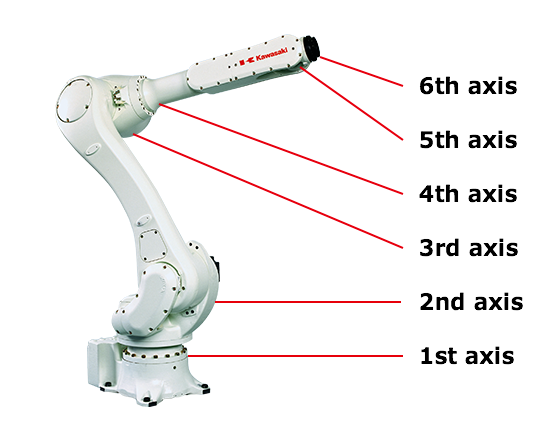
The following figure shows a comparison between robot and human movement.

The 1st to the 3rd axes are the waist and the arm, and the 4th to the 6th axes are from the wrist up to the fingertips. The first three axes carry the wrist to a specific position, and the next three axes move the wrist freely. This 6-axis construction allows robots to move freely like humans can.
Let’s check out the actual movements with a video.
All the axes, from the first to the sixth, move like a human.
What is required to move joints?
Next, let’s examine the internal structure of industrial robots in detail.
The illustration below shows the structure of the small-medium payloads general-purpose robot “R series” from Kawasaki Heavy Industries, or Kawasaki. This R series is active in a broad range of fields such as electronic device assembly and arc welding. Since cables and harnesses can be built inside the arm, interference with peripheral equipment can be avoided and the robot can work in a small space. Its defining feature is speedy operation that can correspond to agile movements.
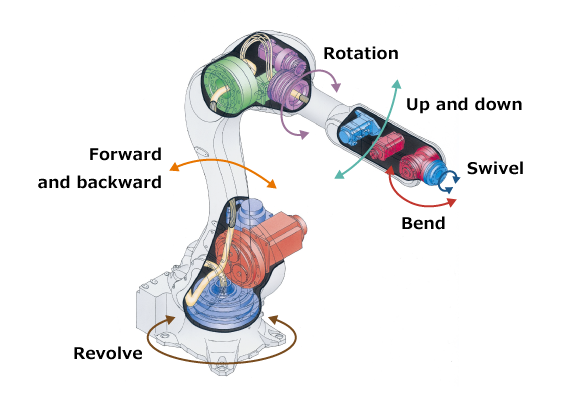
In this illustration, it is clear that a robot is made up of many different parts. Among those parts are four particularly important ones: the actuator, reduction gear, encoder and transmission, all of which will be individually explained.
Actuator
The actuator is a component that functions as the joint of the robot, which allows a robot to move the arm up and down or rotate, and it converts energy into mechanical motions. It may be difficult to grasp this concept, but think about motors as an example. The points marked by red circles in the illustration below are the position of motors of R series.
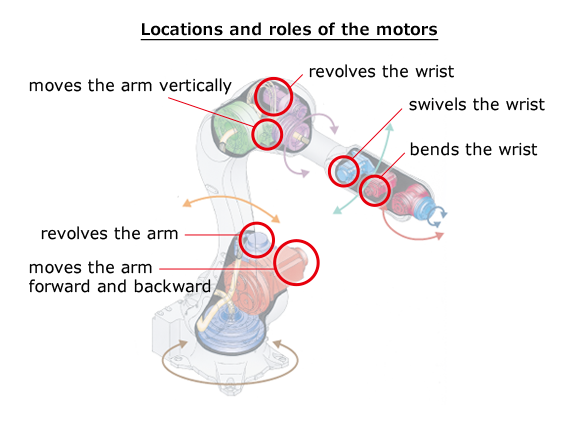
However, if it is a simple motor such as those used in plastic model kits, accurate operation cannot be performed that requires precise movements and accuracy of 0.01mm, for example. Therefore, a highly functional motor called a servo motor, which can control position and speed, is used for industrial robots.
The most common source of energy to power actuators is electricity, but hydraulic and pneumatic energy may also be used. Some hydraulic-powered actuators are unique in that they can generate great power and are shock-resistant.
Reduction gear
A reduction gear is a device for increasing the power of a motor. A motor alone is limited in the amount of power it can output. In order to generate great power, motors are basically used in combination with this reduction gear. The areas circled in blue in the following illustration are the reduction gears.

If you combine gear wheels with the different number of gears and reduce the motor’s rotation by a factor of 10, the power of the motor will be multiplied by 10. This is the same principle as a bicycle transmission. Bicycles have different sized gears in front and rear wheel. Generally, the transmission is used to change the gears of the rear wheel. When a large gear is selected and the number of wheel rotations is minimized, pedaling becomes easier at the cost of speed, but even riding up steep hills is much less difficult. In other words, the output power can be increased.

Encoder
An encoder is a device that indicates the position (angle) of a motor’s rotational shaft. Having an encoder, it can provide tangible data about in what direction and how much the robot moves. General optical encoders have a disk attached to the rotating shaft of the motor. The disk has slits at regular intervals to let light passes and on both sides of the disk are light-emitting-diode (LED) and light receiving elements (photodiodes) to discriminate the light intensity (light and dark).

When the motor rotates, the light either passes through the slits or is blocked, so the rotation angle and speed can be determined by reading the signals. This allows servo motors to precisely control positioning and speed.
Transmission
The transmission is a component that transmits the power generated by the actuators and reduction gears. The transmission is also capable of changing the direction and magnitude of power. Considering a bicycle as an example as before, the chain that connects the crank to the back wheel is the transmission. Bicycles are driven by taking the rotational movement from the pedals and transferring it to the rear wheel using the transmission.

This idea is also applied to the structure of the robot. A motor used in robots is usually placed near the joints, but it can also be placed away from the joints by using transmission mechanisms such as belts and gears. For example, in the wrist of R series robots, since the motor can be installed on the elbow part of the arm by the conduction mechanism, a compact wrist is feasible.
Adding functions with a swappable end effector
Humans can perform various tasks using tools. In the case of industrial robots, swapping the device attached to their wrist make the robots highly versatile and allows them to take on a variety of jobs. This device is called an “end effector”, and there is a vast array of them ready for use including hands for lifting up objects, vacuum (suction) types, and tools for welding and painting. The robot can perform a very wide range of work by combining the flexible movement realized by the robots’ shafts and the task-specific end effectors.
This article detailed the basic structure of industrial robots, and through it we learned about the components that build the structure—where they are located and what role they play. People may think that there is no need to know or learn about how a robot is put together when considering implementing robots in the workplace. However, having a general overview will help make it easier to figure out things such as what kinds of movements and works are possible by looking at the number of axes a robot has or how a robot can be put to use in the company. For companies considering instruction, detailed product information on each industrial robot and application examples are available on Kawasaki’s Robot Division website.
When it comes to actually considering installing robots, even a slight knowledge of the structures and movements of industrial robots may go a long way and lead to more fitting implementation.
